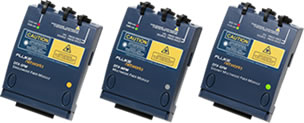Negative loss readings - DTX Fiber Modules
New to DTX 1,3 (![]() ), at the end of the Fiber Autotest, if there is a negative loss of more than -0,09 dB, a warning will be given. "How can I get a negative loss? Isn't that a gainer?" The principle causes of negative loss readings are:
), at the end of the Fiber Autotest, if there is a negative loss of more than -0,09 dB, a warning will be given. "How can I get a negative loss? Isn't that a gainer?" The principle causes of negative loss readings are:
- Incorrect test reference method
- Poor quality reference leads
- Not allowing the source to stabilize
The following articles include a step to verify your Test Reference Cords.
- ANSI/TIA-568-C testing LC to LC Duplex Multimode
- ANSI/TIA-568-C testing LC to LC Duplex Singlemode
- ANSI/TIA-568-C testing SC to SC Duplex Multimode
- ANSI/TIA-568-C testing SC to SC Duplex Singlemode
- ANSI/TIA-568-C testing SC/APC to SC/APC Duplex Singlemode
- ANSI/TIA-568-C testing ST to ST Duplex Multimode
- ANSI/TIA-568-C testing ST to ST Duplex Singlemode

Poor quality reference leads
When you purchase patch cords, you will normally see a loss value enclosed with the patch cord. The generic standard for a mated fiber connection is better than 0,75 dB. Most patch cord vendors will achieve a mated loss better than this. What you may not know is that there is a standard for a reference mated connection. In IEC 14763-3, a mated reference connection is defined as being better than 0,1 dB for multimode and 0,2 dB for singlemode. It is possible with the DTX CableAnalyzer to verify the performance of your reference leads.
Incorrect test reference method
For testing in the local area network, use Method B. If you have the DTX-xFM without the interchangeable adapters, you can do a true Method B with an SC installation only. If your cabling system contains LC connectors for example, then Adapted Method B should be used to produce equivalent results. Both methods are highly dependent on the quality of your reference leads.
Not allowing the source to stabilize
When you set a reference, the CableAnalyzer will store the received power from the output. For example, with a DTX-SFM the receive power may be -6,50 dBm. With your reference leads still in place, running an AUTOTEST should yield 0,00 dB. But, let's assume that the source was not allowed to stabilize (warm up). When the source warms up, the output power of the source will increase. Taking the previous example here, the receive power increased to -6,70 dBm. Running the AUTOTEST again would yield a negative loss of -0,20 dB. How long should it take for the source to stabilize? This will depend on where it was stored and the ambient temperature you are testing at. It can be as little as 5 minutes and as long as 30 minutes if the instrument was stored in a very cold place. Checking to see of the source has stabilized is easy. After setting the reference, run an AUTOTEST. It is not uncommon to see anything from -0,04 dB to 0,04 dB. But, if you see it drifting more than this, keep repeating the AUTOTEST until a stable value is observed.




